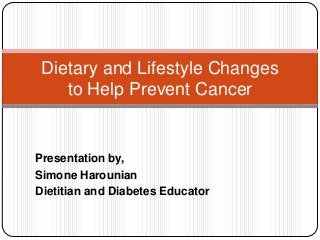
Dietary and Lifestyle Changes to Help Prevent Cancer
- 1. Dietary and Lifestyle Changes to Help Prevent Cancer Presentation by, Simone Harounian Dietitian and Diabetes Educator
- 2. Non-modifiable Genetics Environmental Modifiable Our Focus! Lifestyle Diet What Causes Cancer?
- 3. Modifiable Risk Factors Lifestyle Diet Up to 1/3 of cancers can be avoided with a nutritious diet, maintenance of a healthy weight, and an active lifestyle
- 4. Optimize your diet! 1. Plant-based foods 2. Limit red and processed meats 3. Avoid grilling and frying foods 4. Limit alcohol
- 5. Optimize your diet! 1. Plant-based foods 2. Limit red and processed meats 3. Avoid grilling and frying foods 4. Limit alcohol
- 6. Plant-based Diets High in fruits, vegetables, nuts, beans, etc. Dietary fiber Vitamins, minerals, phytonutrients, and antioxidants Low in total and saturated fat
- 7. Benefits of Dietary Fiber Speeds up digestion Eliminates cancer compounds from the body Changes the bacteria in the gut to good bacteria Getting enough fiber can reduce the risk of: Colorectalcancer Breast cancer Some head/neck cancers
- 8. Sources of Fiber Whole Grains Legumes Vegetables Fruits Recommendations: Men: 32g per day Women: 25g per day (14g of dietary fiber per 1,000 calories daily)
- 9. Benefits of Vitamins and Phytonutrients Act as antioxidants in the body Antioxidants: Reduce cells that damage the body Control cell growth and death These compounds may be protective against: Breast cancer Prostate cancer Bladder cancer Colon cancer Lung cancer Esophageal cancer
- 10. Sources of Vitamins and Phytonutrients Vitamin A: liver, eggs, dairy ß-carotene: carrot, sweet- potato, pumpkin, dark leafy green vegetables Vitamin E: vegetable oils, nuts, leafy green vegetables, sweet potatoes, carrots, and tomatoes Vitamin C: citrus fruits, broccoli, cabbage Recommendations: 2 cups of fruit daily 2.5 to 3 cups of vegetables
- 11. Benefits of Consuming a Low Diet Low intakes of saturated fat may prevent inflammation Inflammation is often associated with cancer Increased waist development circumference and body weight (obesity) may increase the risk of developing: Colon cancer Breast cancer Multiple myeloma
- 12. Optimize your diet! 1. Plant-based foods 2. Limit red and processed meats 3. Avoid grilling and frying foods 4. Limit alcohol
- 13. Limit Red and Processed Meats Some processed Red meats: meats may contain Hamburgers, steak, carcinogens lamb roast, pork Recommendations chops : Processed meats: Eat less than 18 Smoked/cured/salte ounces of red d meat, meat with meat a week to added preservatives reduce cancer risk such as hotdogs, bacon, salami, sausage
- 14. Optimize your diet! 1. Plant-based foods 2. Limit red and processed meats 3. Avoid grilling and frying foods 4. Limit alcohol
- 15. Avoid Grilling and Frying Foods! Cancer causing compounds are produced when animal products are grilled or fried Chemicals formed when fat drips off the meat into flames Try to replace grilling and frying with baking, steaming, or boiling!
- 16. Optimize your diet! 1. Plant-based foods 2. Limit red and processed meats 3. Avoid grilling and frying foods 4. Limit alcohol
- 17. Limit Alcohol Consumption May damage DNA, increasing the risk of cancer High alcohol consumption is associated with: Head and neck cancer Esophagus cancer Mouth cancer Breast cancer Pharynx/Larynx cancer Liver cancer Recommendations: Men: 2 drinks per day Women 1 drink per day
- 18. Summary There are many causes of cancer Some causes can be changed Diet is a modifiable risk factor With these small steps, you can help reduce your risk of cancer-causing agents!
- 19. Questions ?
